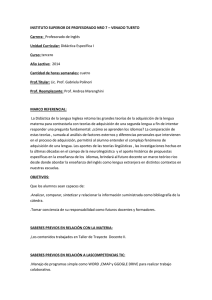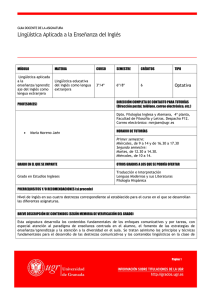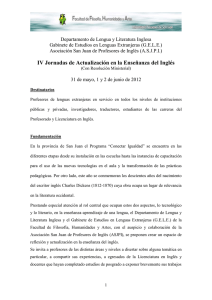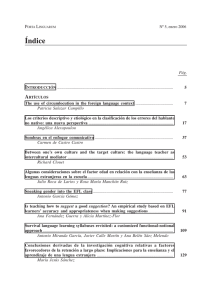METODOLOGA DE LA ENSEANZA DE LA LENGUA INGLESA III
Anuncio
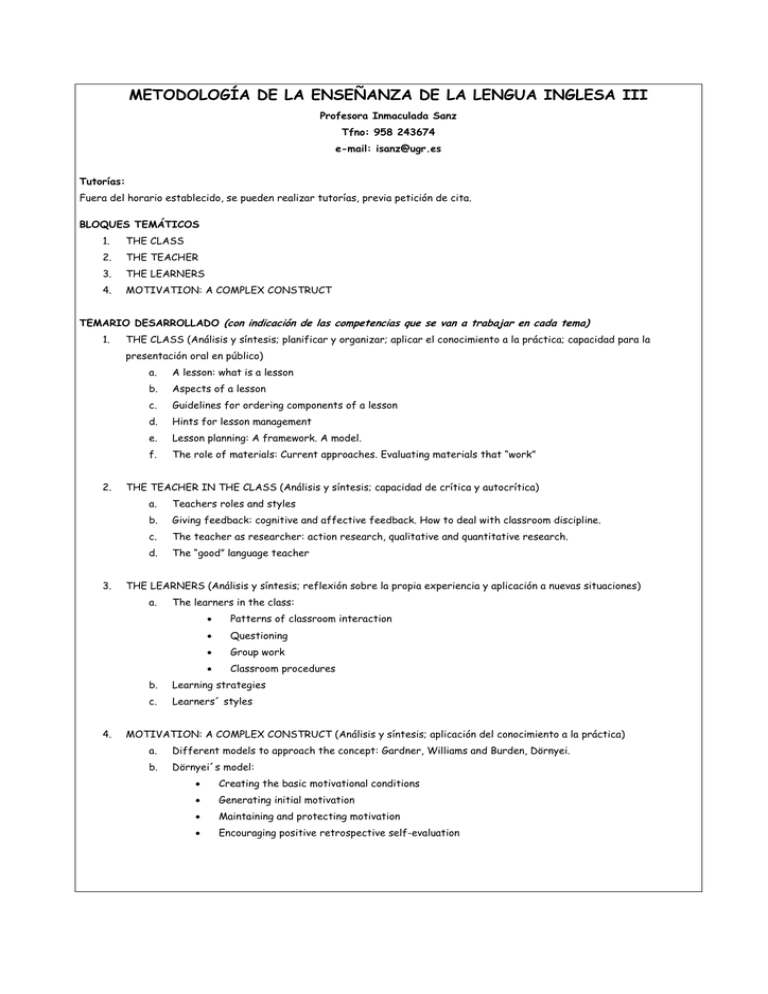
METODOLOGÍA DE LA ENSEÑANZA DE LA LENGUA INGLESA III Profesora Inmaculada Sanz Tfno: 958 243674 e-mail: isanz@ugr.es Tutorías: Fuera del horario establecido, se pueden realizar tutorías, previa petición de cita. BLOQUES TEMÁTICOS 1. THE CLASS 2. THE TEACHER 3. THE LEARNERS 4. MOTIVATION: A COMPLEX CONSTRUCT TEMARIO DESARROLLADO (con indicación de las competencias que se van a trabajar en cada tema) 1. THE CLASS (Análisis y síntesis; planificar y organizar; aplicar el conocimiento a la práctica; capacidad para la presentación oral en público) 2. 3. a. A lesson: what is a lesson b. Aspects of a lesson c. Guidelines for ordering components of a lesson d. Hints for lesson management e. Lesson planning: A framework. A model. f. The role of materials: Current approaches. Evaluating materials that “work” THE TEACHER IN THE CLASS (Análisis y síntesis; capacidad de crítica y autocrítica) a. Teachers roles and styles b. Giving feedback: cognitive and affective feedback. How to deal with classroom discipline. c. The teacher as researcher: action research, qualitative and quantitative research. d. The “good” language teacher THE LEARNERS (Análisis y síntesis; reflexión sobre la propia experiencia y aplicación a nuevas situaciones) a. 4. The learners in the class: • Patterns of classroom interaction • Questioning • Group work • Classroom procedures b. Learning strategies c. Learners´ styles MOTIVATION: A COMPLEX CONSTRUCT (Análisis y síntesis; aplicación del conocimiento a la práctica) a. Different models to approach the concept: Gardner, Williams and Burden, Dörnyei. b. Dörnyei´s model: • Creating the basic motivational conditions • Generating initial motivation • Maintaining and protecting motivation • Encouraging positive retrospective self-evaluation BIBLIOGRAFÍA Bibliografía obligatoria Brown, D. 1987. In the classroom: Error correction. Principles of Language Learning and Teaching. Englewood Hall. Prentice Hall Regents. 192-195. Brown, D. 1994. Lifelong Learning: Continuing Your Teacher Education. Teaching by Principles. Englewood Hall. Prentice Hall Regents.425-443. Bailey, K. 1996. The best laid plans: teachers´ in class decisions to depart from their lesson plans. In K. Bailey and D. Nunan, ed. Voices from the language classroom. Cambridge: CUP. 15-40. Dörnyei, Z. 2001. Background knowledge. In Motivational Strategies in the Language Classroom.Cambridge: CUP. 330. McDonough and Shaw, C. 1993. Evaluating ELT materials. In Materials and Methods in ELT. Oxford Blackwell. 6380. Rosenthal, R. and Jacobson, L. 1966. Teachers´ expectancies: Determinates of pupils´ IQ gains. Psychological Reports 19: 115-118 Seligman, M.E.P. and Maier, S.F. 1967. Failure to escape traumatic shock. Journal of Experimental Psychology 74: 19. Skinner, B.F. 1948. Superstition in the pigeon. Journal of Experimental Psychology 38: 168-172. Ur, P. 1999. Module 15: Lesson Planning. A Course in Language Teaching. Cambridge: C.U.P. 213-227 Ur, P. 1999. Module 17: Giving Feedback. A Course in Language Teaching. Cambridge: C.U.P. 242-258. Ur, P. 1999. Module 18: Classroom discipline. A Course in Language Teaching. Cambridge: C.U.P. 259-272. Oxford, Rebecca L.1990. Language learning strategies: what every teacher should know. Boston : Heinle and Heinle, 1990 Bibliografía recomendada • Celce-Murcia, M. and McIntosh, L. (ed.) 2001. Teaching English as a Second or Foreign Language. Third Edition . Boston: Heinle and Heinle • • Hedge, T. 2000. Teaching and Learning in the Classroom. Oxford: Oxford University Press. Johnson, K and Johnson, H. 1998. Encyclopaedic Dictionary of Applied Linguistics: A Handbook for Language Teaching. Oxford: Blackwell • Kumaravadivelu, B. 2003. Beyond methods: Macrostrategies for language teaching. New Haven and London: Yale University Press. • Lightbown, P.M. and Spada, N. 1993. How Languages are Learnt. Oxford: Oxford University Press. • Mackay, S. L. 2003. Towards an appropriate EIL pedagogy: re-examining common ELT assumptions. International Journal of Applied Linguistics 13.1 • Richards, J and Renandya, A. (eds.). 2002. Methodology in Language Teaching. Cambridge: Cambridge University Press. • • Schmitt, N. 2002. An Introduction to Applied Linguistics. Oxford, New York: Arnold. Yamasaki, S. & T. Yamasaki. 1999. The role of affect in language learning with implications for teaching in Japan. Explorations in Teacher Education 7.2 TÉCNICAS DE EVALUACIÓN 1. Se controlará la asistencia y la participación activa. 2. Se elaborará un resumen de cada lectura y se entregará por escrito. 3. Se elaborará un trabajo en grupo, pero cada miembro hará una exposición individual. 4. Habrá un examen final. Es necesario aprobar el examen para que se tengan en cuenta los demás aspectos de la evaluación. Criterios de evaluación y calificación (referidos a las competencias trabajadas durante el curso): Se tendrán en cuenta el dominio por parte de los estudiantes de los contenidos del temario, así como su capacidad expositiva, su dedicación a la asignatura; también se valorará el desarrollo de las capacidades de crítica y autocrítica, la capacidad de trabajar en equipo, la motivación de logro y la preocupación por la calidad de su propio aprendizaje.
